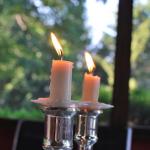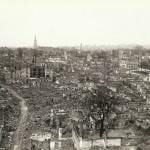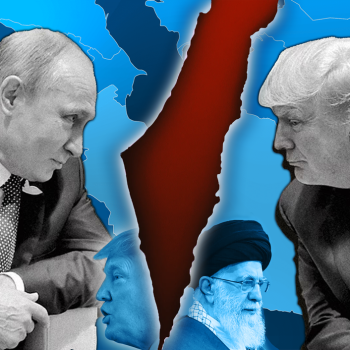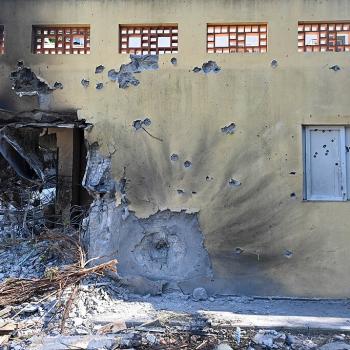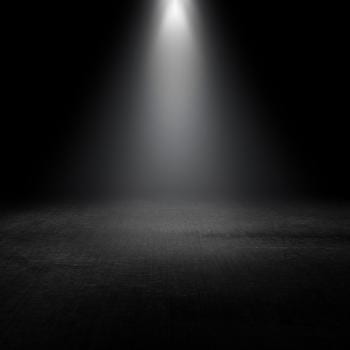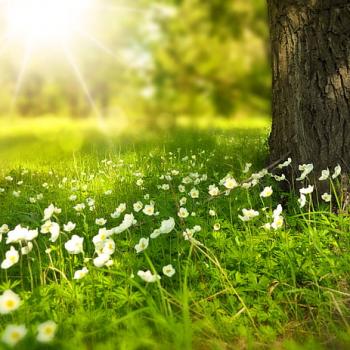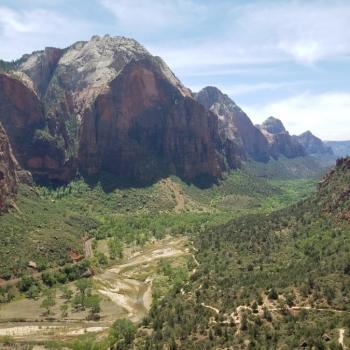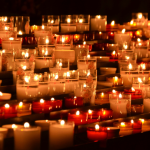The Hebrew scriptures make it clear that God’s presence is everywhere. But with that said, many spiritually powerful things happen in the wilderness.
God commands Pharoah to let his people go so they can go worship God in the wilderness. And at their liberation, that’s where God leads them – to experience Sinai, to wander, to find themselves and the divine.
The same themes of being made vulnerable in the wilderness – experiencing awakening and gaining insight – can be seen with Moses. Prior to the Exodus, he flees Egypt to avoid bondage and punishment and renews his life and finds his true self out in nature, away from the cities, while tending sheep. He encounters the meaning of his life and learns his vocation at the Burning Bush.
The Flame that Shines but does not Consume
Moses is out wandering when he stumbles upon the strange sight of a bush on fire. What’s strange is that the bush is aflame, but not being burned. Out of this strange, flaming bush, the divine erupts from within nature, and God speaks to Moses, telling him to free the Israelites and then, sharing with Moses the divine, cryptic name of Eyeh asher Eyeh.
Unlike other revelatory experiences, God doesn’t speak from above the skies, as in a Bat Tol, a voice from heaven, but rather speaks from the land, from within nature, not beyond it.
The implications here for an immanent theology are many, with the sense of the indwelling of the divine light within nature, how that light burns, illuminates, yet seemingly animates and not destroys. Further implied is the immense potential of finding God and meaning in the wilderness, within the world, at moments when we are removed from the more artificial aspects of human life. The burning bush is a story of the God of nature speaking forth from within the world.
I’m reminded of the words of Irish Jesuit poet, Gerard Manley Hopkins, from his famous poem, God’s Grandeur (1877):
The world is charged with the grandeur of God.It will flame out, like shining from shook foil.
The Divine within the World & Spiritual Ecology
Nuanced theology balances the concerns of immanence and transcendence. The divine energy is infused within the world, but cannot be reduced to the world, and yet is universal and creative, serving as the ground of being, therefore transcendent in terms of its providing the noncontingent wellspring for all that exists.
Jewish sacred writings and Jewish theology certainly support this sense of balanced immanence.
One approach with merit is to understand divinity as the context and creative source of being – the creative imprint that remains infused throughout all creation – the underlying, organizing force that brings order out of chaos and potentiality – the telos embedded in reality driving emergence into ordered complexity and toward life. In this sense, the traditional Western concept of monotheism, which greatly owes its genesis to the Jews, is the apprehension of a unified immanent presence, yet transcendent value source.
In my opinion, the past two centuries of Western theology have overemphasized the transcendent aspects of divinity, positing a God beyond the world to the extent that this God is alienated and disconnected from the world. This alienation is reflected in our theological denigration of this world, focusing unwarranted attention on “the world to come” or the “heavens beyond this limited world.” Such denigration is at the roots of many unnecessarily negative views of the human body and pleasure, of our casual, utilitarian destruction of nature, and of many unfairly downplaying the concerns of justice, freedom, and care of the needy in this world, in favor of some elusive, other-worldly spirituality (or worse, spiritual warfare) of realms beyond.
Judaism is much less prone to these temptations. Rather, they have exhibited themselves more prominently within Christianity. This is not to say that Judaism is without flaws or excess, but it is to note that most Jewish thinking is much more fundamentally positive about the goodness of life, of this world, and of nature than are many strands of Christian theology.
I’ve mentioned in previous posts that a central thrust of spiritual ecology is systems thinking. Ecology can be broadly, but correctly, understood as the study of interwoven, embedded systems, be they ecological, human, or a blending of both. Most forms of spiritual ecology share two foundational theological insights:
1) The divine is both the ground of all systems, yet is fully within the one, grand system, thus collapsing the need for a divide between the supernatural and the natural. This exhibits itself in forms of panentheism and moderate naturalist claims.
2) God and the meaning of our lives, is found in this world. And that nature – the wilderness – plays a central, sacramental role in conveying the divine power at work in the world and within our lives.
Perhaps the defining characteristic of our secular age is the desacralization of the world and nature – a rendering nature as flat, lifeless, and unimportant in such ways as to perceive nature as spiritually meaningless. A pivotal aim of spiritual ecology, and Judaism, is to recapture a sense of the sacredness of the world and nature. Resacralization restores the sacred dimensions of nature which return nature to a spiritually charged state which is perceived as enchanted, vibrant, meaningful, and imbued with divine energy, rather than being perceived as flat and mechanical. In spiritual ecology, nature is understood as an interconnected web of vitality, with God at the center and imbued throughout.
Our experience of this sacredness – nature’s and our own – address us as persons, asking us to freely dispose of ourselves in accord with our highest values, inspiring us to live in harmony with nature, and calling us beyond ourselves to relationship, service, and love. Isn’t this, in many ways, the primary message of Torah?
We need to foster a culture that affirms the sacredness of nature and the dignity of human beings. We need to foster a culture that once again engages nature as sacred in that we stand in awe at the beauty, preciousness, oneness and interconnectedness of everything.
Spiritual ecology is fostering the emerging realization that what we hold as sacred is not “out” or “up” in the heavens, but right here, grounded in nature. Many find a sacred aspect within natural activity – the unity and teleos of the processes or powers within the natural order. In this sense, we hold sacred those goods and powers that lead to the fulfillment of nature, including human nature, and these powers are completed infused within nature and operate within the natural order.
Going Forward
This ends the current posts on spiritual ecology and how it relates to Judaism. Our hope is to have the Center for Spiritual Ecology fully online by early May. The Center will continue to develop these themes in blog posts, articles, and conferences. Our goal is to help connect various groups and individuals engaged in similar work.
The Center will be interfaith. We are currently reaching out to other Jews, Christians, Neopagans, Buddhists … and others … to solicit their input, serve on the board of directors, and help draw out the nature-based insights of their own traditions.
In the meantime, this blog will continue to focus on various themes of Liberal Judaism and what it has to offer our world. I hope you stay part of the conversation.

